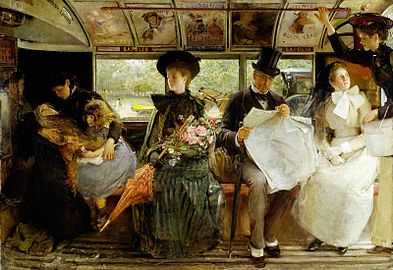George W. Joy
George W. Joy | |
|---|---|
South Kensington School of Art, London | |
| Known for | Painter of genre, historical scenes and Orientalist themes |
| Movement | Orientalist |
George William Joy (7 July 1844 in
Life and career
Joy was the son of William Bruce Joy, MD, and the brother of sculptor

He was initially destined for the military and was also an accomplished violin player. After a foot injury at young age, his father declared him unfit for military service. Joy was then educated at
In 1868 Joy went to
Going back to London, Joy established himself as a
To satisfy his early military ambitions, Joy entered the Artists Rifles where he was known as a good shot, representing Ireland several times. He spent many winters in Swanage from 1896 and eventually retired to Purbrook. Both of his sons were killed in 1915 during World War I.[2]
Works
Joy's paintings covered a variety of themes from strictly historical to religious and allegorical. He also painted portraits.
His pursuit of the perfect female form in
Opposing
He was perhaps best known for his depiction of
Another well known, yet profoundly different work by Joy is the highly contemporary scene The Bayswater Omnibus (1895; Museum of London - image here).
One of his most evocative paintings is Joan of Arc, guarded in her sleep by an angel (1895; Rouen, Musée des Beaux Arts - image here).
-
A dinner of herbs
-
An English Drummer Boy (1902)
References
- ^ "JOY, George William". The International Who's Who in the World: 648. 1912.
- ^ a b Snoddy, Theo. Dictionary of Irish Artists: 20th Century, 2nd Edition. Merlin Publishing, Dublin, Ireland, 2002, pages 290–292. Retrieved March 26, 2008.
- Allgemeines Künstlerlexikon, vol. 76/77, 2013 (in preparation).
- The work of George W. Joy with an autobiographical sketch, London, Cassell, 1904.
- George W. Joy from Grove Art Online via ArtMagick.



